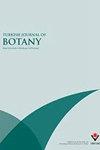Distributional ecology of Noccaea vesicaria in relation to the Anatolian Diagonal
IF 1.5
4区 生物学
Q3 PLANT SCIENCES
引用次数: 0
Abstract
: Anatolia is located at the intersection of three of the world’s 36 biodiversity hotspots (the Caucasus, Irano-Anatolian, and Mediterranean Basin biodiversity hotspots) and has about 10,000 plant species, over 3000 of which are endemic. Among the many reasons for the astonishing biodiversity of Anatolia, one that stands out is the Anatolian Diagonal. Although the Anatolian Diagonal has long been recognized as a biogeographical boundary between Central and Eastern Anatolia, its exact functioning is still not well understood. Thus, in this study, our aims were 1) to assess the environmental barrier function of the Anatolian Diagonal for a plant species, Noccaea vesicaria , living on and to the east of it; 2) to evaluate climate-driven range shifts (contractions or expansions), especially through the Quaternary glacial–interglacial cycles; and 3) to contribute to the long-standing debate on the causes of the floral break between the west and east of the Anatolian Diagonal. Accordingly, we used an ecological niche modeling approach with presence records and bioclimatic data. Under the present bioclimatic conditions, areas of more suitable bioclimatic conditions were observed, especially throughout and to the east of the Anatolian Diagonal, therefore largely matching the geographical distribution of N. vesicaria . However, areas of high bioclimatic suitability were also observed to the west of the Anatolian Diagonal, especially throughout the Taurus Mountains and Pontic Mountains. Thus, bioclimatic suitability by itself cannot explain the geographical distribution of N. vesicaria or the absence of it, especially to the west of the Anatolian Diagonal. Under the past bioclimatic conditions, areas of high bioclimatic suitability contracted during warmer time periods and expanded during colder time periods, suggesting that the geographical distribution of N. vesicaria contracted and expanded during warmer and colder time periods, respectively, at least around and in the Anatolian Highlands. There may be two reasons why N. vesicaria does not occur to the west of the Anatolian Diagonal: dispersal and/or biotic interactions (e.g., competition and facilitation). Biotic interactions (likely positive plant interaction or facilitation) may have played a significant role in shaping the geographical distribution of N. vesicaria , because it seems to be highly associated with the Anatolian Highlands steppe order Festuco oreophilae-Veronicetalia orientalis Hamzaoğlu whose range does not extend to Central Anatolia.与安纳托利亚对角线有关的水藻分布生态学
:安纳托利亚位于世界36个生物多样性热点(高加索、伊朗-安纳托利亚和地中海盆地生物多样性热点)中的3个的交汇处,拥有约1万种植物,其中3000多种是特有的。在安纳托利亚令人惊叹的生物多样性的众多原因中,安纳托利亚对角线是一个突出的原因。虽然安纳托利亚对角线长期以来一直被认为是安纳托利亚中部和东部之间的生物地理学边界,但其确切功能仍未得到很好的理解。因此,在本研究中,我们的目标是:1)评估生活在安纳托利亚对角线上及其以东的一种植物Noccaea vesicaria的环境屏障功能;2)评估气候驱动的范围移动(收缩或扩张),特别是通过第四纪冰期-间冰期旋回;3)为长期以来关于安纳托利亚对角线西部和东部花卉断裂原因的争论做出贡献。因此,我们利用存在记录和生物气候数据的生态位建模方法。在目前的生物气候条件下,主要分布在安纳托利亚对角线及其以东的生物气候条件较为适宜的地区,与水仙的地理分布基本吻合。然而,在安纳托利亚对角线以西也观察到高生物气候适宜性的地区,特别是在整个托罗斯山脉和本蒂克山脉。因此,生物气候适宜性本身并不能解释水仙花的地理分布或不存在,特别是在安纳托利亚对角线以西。在过去的生物气候条件下,高生物气候适宜性区域在温暖时期收缩,在寒冷时期扩张,表明在温暖时期和寒冷时期,至少在安纳托利亚高原周围和在安纳托利亚高原地区,水草的地理分布分别收缩和扩张。可能有两个原因可以解释为何无毛蝽没有出现在安纳托利亚对角线以西:扩散和/或生物相互作用(例如竞争和促进)。生物相互作用(可能是积极的植物相互作用或促进作用)可能在形成褐毛蕨的地理分布中发挥了重要作用,因为它似乎与安纳托利亚高原草原目Festuco oreophilae-Veronicetalia orientalis Hamzaoğlu高度相关,其范围不延伸到安纳托利亚中部。
本文章由计算机程序翻译,如有差异,请以英文原文为准。
求助全文
约1分钟内获得全文
求助全文
来源期刊

Turkish Journal of Botany
PLANT SCIENCES-
CiteScore
2.90
自引率
5.60%
发文量
31
审稿时长
6-12 weeks
期刊介绍:
The Turkish Journal of Botany is published electronically 6 times a year by the Scientific and Technological Research Council of Turkey (TÜBİTAK) and accepts manuscripts (in English) covering all areas of plant biology (including genetics, evolution, systematics, structure, function, development, diversity, conservation biology, biogeography, paleobotany, ontogeny, functional morphology, ecology, reproductive biology, and pollination biology), all levels of organisation (molecular to ecosystem), and all plant groups and allied organisms (algae, fungi, and lichens). Authors are required to frame their research questions and discuss their results in terms of major questions in plant biology. In general, papers that are too narrowly focused, purely descriptive, or broad surveys, or that contain only preliminary data or natural history, will not be considered (*).
The following types of article will be considered:
1. Research articles: Original research in various fields of botany will be evaluated as research articles.
2. Research notes: These include articles such as preliminary notes on a study or manuscripts on the morphological, anatomical, cytological, physiological, biochemical, and other properties of plant, algae, lichen and fungi species.
3. Reviews: Reviews of recent developments, improvements, discoveries, and ideas in various fields of botany.
4. Letters to the editor: These include opinions, comments relating to the publishing policy of the Turkish Journal of Botany, news, and suggestions. Letters should not exceed one journal page.
(*) 1. Raw floristic lists (of algae, lichens, fungi, or plants), species descriptions, chorological studies, and plant sociology studies without any additional independent approaches.
2. Comparative morphology and anatomy studies (that do not cover a family, tribe, subtribe, genus, subgenus, section, subsection, or species complexes with taxonomical problems) without one or more independent additional approaches such as phylogenetical, micromorphological, chromosomal and anatomical analyses.
3. Revisions of family, tribe, genus, subgenus, section, subsection, or species complexes without any original outputs such as taxonomical status changes, IUCN categories, and phenological and ecological analyses.
4. New taxa of all plants without any additional independent approaches such as phylogenetical, ecological, chromosomal, chorological and correlational analyses in addition to a detailed macro- and micro-morphological descriptions with quality field and microscopic illustrations of taxonomically important structures and identification key in the taxonomic group.
New records of all plants without any additional independent approaches such as phylogenetical, ecological, chromosomal, chorological and correlational analyses in addition to a detailed macro- and micro-morphological descriptions with quality field and microscopic illustrations of taxonomically important structures and identification key in the taxonomic group may be accepted for peer review if they contain 3 or more new records or taxonomical status update, such as lectotypification, new combinations, transfers, revivals and synonyms.
5. New taxa of algae, lichens, and fungi without any additional independent approaches such as phylogenetical, ecological, chromosomal, chorological and correlational analyses in addition to a detailed macro- and micro-morphological descriptions with quality field and microscopic illustrations of taxonomically important structures and identification key in the taxonomic group.
New records of algae, lichens, and fungi without any additional independent approaches such as phylogenetical, ecological, chromosomal, chorological and correlational analyses in addition to a detailed macro- and micro-morphological descriptions with quality field and microscopic illustrations of taxonomically important structures and identification key in the taxonomic group may be accepted for peer review if they contain 5 or more new records or taxonomical status update, such as lectotypification, new combinations, transfers, revivals and synonyms.
 求助内容:
求助内容: 应助结果提醒方式:
应助结果提醒方式:


